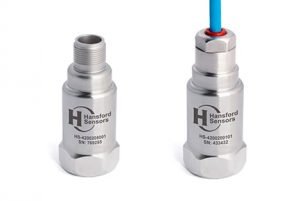How to Choose a Vibration Sensor
How to Choose a Vibration Sensor
Choosing the right Hansford Sensors vibration sensor (accelerometer/vibration sensor) to suit your preference can be quite challenging from a range of varieties, shapes and sizes. It is also crucial to select the right vibration sensor. For this reason, there are important factors that you should follow to ensure the accuracy of your determination.

Measure Range and Sensitivity on Vibration Sensors
Measure range varies widely on each application fields. In order to obtain maximum vibration ranges in your measurements, you should specify the correct vibration sensor. In standart applications (50g range), typical vibration sensor’s sensitivity range is 100mV/g. This value will be 500mV/g at the lower vibration applications (10g).
Vibration Frequency
The frequency range you have to measure is important as vibration measurement range. These frequency ranges are determined by the fault frequencies of the fastest rotating component in the monitored machine. Fastly turning fan’s frequency range is much wider than slowly turning ball mill’s frequency range.
Ambient Temperature
Poor assembly is a big thread for performance of the vibration sensors in the same place. High temperature, effects to the electronic components performance directly. However, there are charge-mode velocity transmitters (accelerometer) that designed for operate at the very high temperatures.
Contact with chemicals or debris
These factors can significantly reduce the accuracy of results. Therefore, it is important to pay attention to these factors while specifying the vibration sensor. In order to sure of the sensor’s performance and accuracy of the measurement values, the sensor should be isolated from the environmental factors like chemicals and debris. For this reason, while choosing the sensor, stainless steel body should be preferred in order to avoid these environmental factors. Hansford Sensors products have completely stainless steel body that provide reliable output values even in the extreme ambient situations.
Hazardous Environments
Hazardous environments are those where a small spark can cause a fire or explosion. There are combustible and explosive gasses, ignitable dusts or flammable fibers in these environments. In order to protect operators, machines and overall production in this field, it is quite important to use intrinsically safe accelerometers. These velocity transmitters (accelerometers) can fit easily to the those mentioned hazardous environments. Besides, they are operating completely same with the standart accelerometers. But their operating conditions are far more safe than the standard ones.
Immersion in liquid
Typical accelerometers are structurally not durable to the liquid. If accelerometer have to contact with liquid in the application area, it should be specified before. For this reason its important to prefer vibration sensor that integrated with polyurethane sheathed cable. This cable type prevents any possible damage to the sensor and electronic components by cutting the leak of liquid. However, even if the sensor’s contact with the liquid is permanent, its operating performance is not affected.
Exit and Profile
Exit and profile of an vibration sensor is minimal in performance. Yet, any fault in this part affects directly the vibration sensor’s operating quality. There are placement specifications on vibration sensors like horizontal, vertical or axial. These connection types provide efficient measurement.
Considering these factors, you can choose the right vibration sensor for your application. You can click here to browse more of our vibration sensor products.

